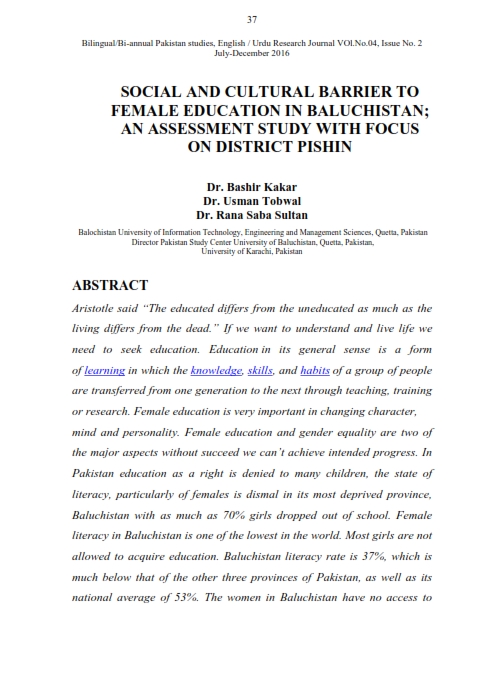SOCIAL AND CULTURAL BARRIER TO FEMALE EDUCATION IN BALUCHISTAN; AN ASSESSMENT STUDY WITH FOCUS ON DISTRICT PISHIN
Keywords:
Cultural barriers, Social barriers, Female Education, Women education, Girls educationAbstract
Aristotle said “The educated differs from the uneducated as much as the
living differs from the dead.” If we want to understand and live life we
need to seek education. Education in its general sense is a form
of learning in which the knowledge, skills, and habits of a group of people
are transferred from one generation to the next through teaching, training
or research. Female education is very important in changing character,
mind and personality. Female education and gender equality are two of
the major aspects without succeed we can’t achieve intended progress. In
Pakistan education as a right is denied to many children, the state of
literacy, particularly of females is dismal in its most deprived province,
Baluchistan with as much as 70% girls dropped out of school. Female
literacy in Baluchistan is one of the lowest in the world. Most girls are not
allowed to acquire education. Baluchistan literacy rate is 37%, which is
much below that of the other three provinces of Pakistan, as well as its
national average of 53%. The women in Baluchistan have no access to
education, due to cultural barriers and lack of resources as well. Cultural
barriers to female education in Baluchistan are a major issue. Women in
Baluchistan have no expectation and dreams as there are very rare
opportunities and many cultural barriers for them.
References
Abbasi, S. (1990). Profile of women of Balochistan. Government of
Balochistan and UNICEF.
AHMAD, S. F. (2008 ). EDUCATION FOR ALL MID-DECADE
ASSESSMENT COUNTRY REPORT . Government of Pakistan.
Butt, Q. (2011, 11 24). 90% of girls in rural Balochistan remain
unschooled. The Express Tribune .
Dewey, J. (2008 ). Democracy and Education. David Reed, and David
Widger.
Gaag, N. v. (2008). Because I am a Girl. Amadeus, Italy on recycled
paper.
Go, D. n. (2010). Global Monitoring Report 2010. The World Bank.
NNI. (2013, 01 14). Pakistan allocates only 2.3 percent of budget for
education. Retrieved 11 22, 2015, from
PAKISTAN: Balochistan’s girls miss out on education. (n.d.). Retrieved
15, 2015, from IRIN: http://www.irinnews.org/report/60524/pakistanbalochistan-s-girls-miss-out-on-education
Rai, S. M. (2007). Achieving Gender Equality in Public Offices in
Pakistan. Islamabad: UNDP.
Reggie. (2015). E-Learning Made Easy: A Student’s Guide About
Studying Online. Singapore: Partridge Publishing Singapore.
SHAH, S. A. (2014, 12 31). Female literacy hits new low in Balochistan.
Retrieved 11 15, 2015, from http://www.dawn.com/news/1154252
Worldbank. (2011). World Bank Report 2011. World Bank.



